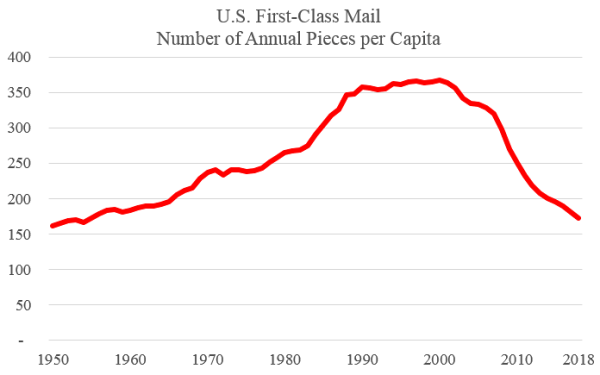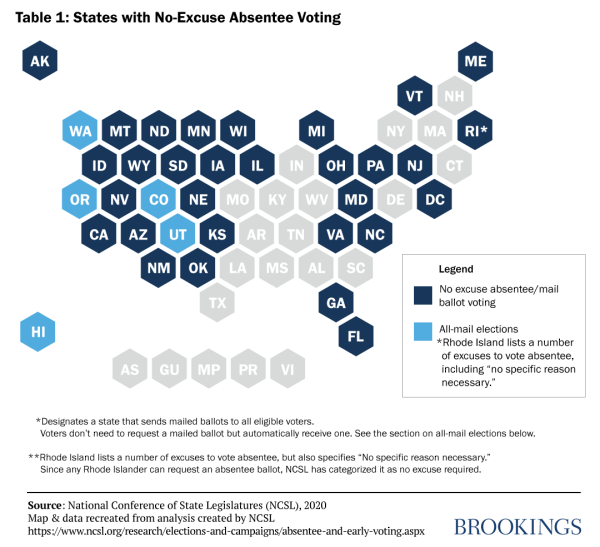The USPS postal service has been major news in recent weeks with mail-in voting being discussed, President Trump making clear he believes there will be corruption if he allows it, and the Postmaster-General removing hundreds of sorting machines. Then, a few days ago, the House voted to block recent changes and to allocate $25 billion to the postal service.
The goal of this article is to highlight the issues with as little politics as possible. This will not consider the timing of the President's actions or the claims that these actions were designed to limit a portion of the electorate's impact on the outcome of the election.
To start, a United States postal service is mentioned in the constitution - but it doesn't state that the federal government has the exclusive power to deliver mail, nor does it require the mail be delivered by the federal government to every home in the country, six days a week. The U.S. Constitution, in 1789, authorized Congress to establish “Post Offices and post Roads” but, unlike the Articles of Confederation, did not explicitly establish an exclusive monopoly.
The USPS has been in a "financial crisis" for a long time, as more volume goes to competitors like UPS or FedEx. It's worth acknowledging that like many other governmental agencies (i.e. the military, the CDC, the weather service, NASA) it costs more to run than it makes. It's also worth acknowledging that the post office doesn't cost tax dollars, but survives primarily off of postage sold.
 via CATO
via CATO
Much of what the USPS offered to the general public is now done by private companies - and it could be argued, without the USPS's legal monopoly over letters and mailboxes, they could fill in some of those roles. The main people who benefit from the USPS are small businesses and rural communities.
While the USPS isn't profitable, many other delivery services are (look at UPS). Part of this is because UPS will not deliver to places that don't have the volume for bundling. And, when they do ship to remote places, they charge more to justify the effort.
A federal mail service currently provides stable costs across volume and distance (for the most part) but is that a reason to keep it?
As a practical matter, public services can't be held to the same standards of profitability as private industry, but we have to be cognizant of the point of diminishing returns on public services.
Absentee Voting Versus Universal "Vote by Mail"
Absentee voting requires you to request a ballot ahead of time, meaning it's associated with a specific voter request. Vote by mail sends a ballot to all registered voters within a jurisdiction.
In America, we don't have to vote by mail, but most states allow absentee voting without the need for a valid excuse.
 via Brookings Institute
via Brookings Institute
In 2016, nearly one-quarter of U.S. votes were cast by mail. A Stanford study shows no partisan effect on absentee voting, and similar levels of voter fraud to in-person voting (though there are cases of fraud) but as we know in trading, past performance does not guarantee future results.
As with in-person voting, the main issue ultimately comes down to the integrity of the results. We've had numerous issues with flawed voting machines, ballot box stuffing, unregistered voters casting ballots, hanging chads, gerrymandering, and a host of issues. For a fair election, the goal is to minimize (or eliminate) election fraud, election manipulation, or vote-rigging. The rules, regulations (and even the process) should discourage or prevent illegal interference with the process of an election, either by increasing the vote share of the favored candidate, depressing the vote share of the rival candidates, or both.
November should be interesting.
Gartner's 2020 Hype Cycle For Emerging Technologies
Each year, I share an article about Gartner's Hype Cycle for Emerging Technologies. It's one of the few reports that I make sure to track every year. It does a good job of explaining what technologies are reaching maturity, but which technologies are being supported by the cultural zeitgeist.
Technology has become cultural. It influences almost every aspect of every-day life, and it's also a massive differentiator in today's competitive landscape.
Sorting through which technologies are making real waves (and will impact the world) and which technologies are a flash in the pan, can be a monumental task. Gartner's report is a great benchmark to compare reality against.
2019's trends lead nicely into 2020's trends. While there have been a lot of innovations, the industry movers have stayed the same - advanced AI and analytics, post-classical computing and communication, and the increasing ubiquity of technology (sensors, augmentation, IoT, etc.).
What's a "Hype Cycle"?
As technology advances, it is human nature to get excited about the possibilities and to get disappointed when those expectations aren't met.
At its core, the Hype Cycle tells us where in the product's timeline we are, and how long it will take the technology to hit maturity. It attempts to tell us which technologies will survive the hype and have the potential to become a part of our daily life.
Gartner's Hype Cycle Report is a considered analysis of market excitement, maturity, and the benefit of various technologies. It aggregates data and distills more than 2,000 technologies into a succinct and contextually understandable snapshot of where various emerging technologies sit in their hype cycle.
Here are the five regions of Gartner's Hype Cycle framework:
Understanding this hype cycle framework enables you to ask important questions like "How will these technologies impact my business?" and "Which technologies can I trust to stay relevant in 5 years?"
That being said - it's worth acknowledging that the hype cycle can't predict which technologies will survive the trough of disillusionment and which ones will fade into obscurity.
What's exciting this year?
Before I focus on this year, it's important to remember that last year Gartner shifted towards introducing new technologies at the expense of technologies that would normally persist through multiple iterations of the cycle. This points toward more innovation and more technologies being introduced than in the genesis of this report. Many of the technologies from last year (like Augmented Intelligence, 5G, biochips, the decentralized web, etc.) are represented within newer modalities.
It's also worth noting the impact of the pandemic on the prevalent technologies.
For comparison, here's my article from last year, and here's my article from 2015. Click on the chart below to see a larger version of this year's Hype Cycle.
via Gartner
This year's ~30 key technologies were selected from over 2000 technologies and bucketed into 5 major trends:
I'm always most interested in the intersection of AI and advanced analytics. This year, it looks like many of the fledgling AI technologies have become integrated and more advanced. Much like the formative years for children, formative AI represents a new era in AI maturity. Models are becoming more generalized, and able to attack more problems. They're becoming integrated with human behavior (and even with humans as seen in digital me).
As we reach new echelons of AI, it's actually more likely that you'll see over-hype and short-term failures. As you reach for new heights, you often miss a rung on the ladder... but it doesn't mean you stop climbing. More importantly, it doesn't mean failure or even a lack of progress. Challenges and practical realities act as force functions that forge better, stronger, more resilient, and adaptable solutions that do what you wanted (or something better). It just takes longer than you initially wanted or hoped.
To paraphrase a quote I have up on the wall in my office from Rudiger Dornbusch ... Things often take longer to happen than you think they will, and then they happen faster than you thought they could.
Many of these technologies have been hyped for years - but the hype cycle is different than the adoption cycle. We often overestimate a year and underestimate 10.
Which technologies do you think will survive the hype?
Posted at 09:11 PM in Business, Current Affairs, Gadgets, Ideas, Market Commentary, Science, Trading Tools, Web/Tech | Permalink | Comments (0)
Reblog (0)